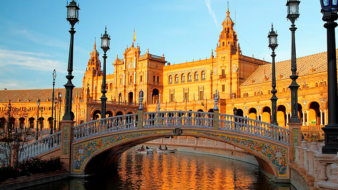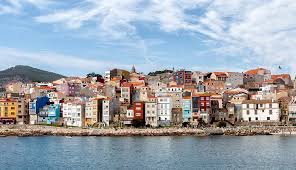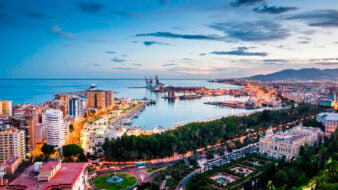Popular Walking Routes in Barcelona
Barcelona, with its rich history, cultural landmarks, and stunning architecture, attracts millions of tourists from all over the world every year. Exploring the city's picturesque streets and neighborhoods on foot is one of the best ways to truly get to know it. With the help of navigation through popular walking routes, you can discover Barcelona from the inside, admire its magnificent architecture, experience Spanish cuisine, and immerse yourself in the unique atmosphere of the Catalan capital. So, what should you see in Barcelona?
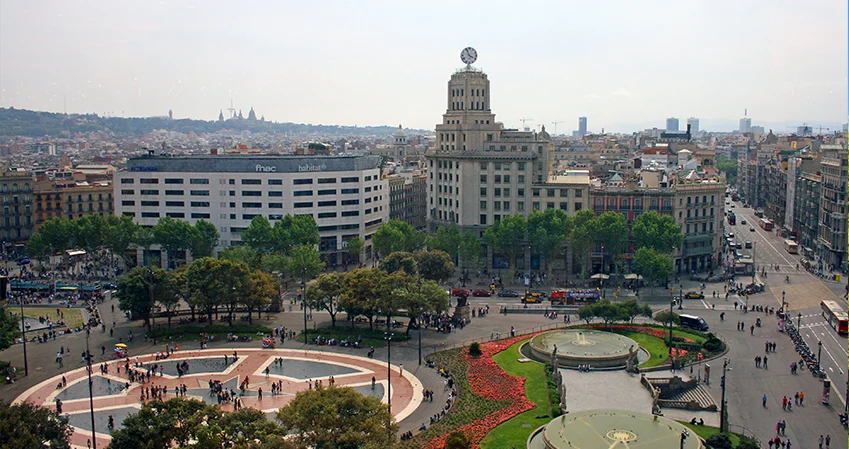 The walk begins at the famous Plaça de Catalunya, the unofficial center of Barcelona. It serves as a connecting point between the Old Town and the Eixample district (the New Town). The square covers more than 50,000 m² and is the starting point of nine streets in Barcelona. The center is paved with colorful granite tiles. In front of the Spanish Credit Bank building, you'll find two large fountains and a small square adorned with antique statues. Locals often relax on the lawn next to the fountains during their lunch breaks. Plaça de Catalunya is a symbolic place for the Catalan capital and hosts demonstrations, exhibitions, and festivals—such as the Mercè Festival in autumn.
The walk begins at the famous Plaça de Catalunya, the unofficial center of Barcelona. It serves as a connecting point between the Old Town and the Eixample district (the New Town). The square covers more than 50,000 m² and is the starting point of nine streets in Barcelona. The center is paved with colorful granite tiles. In front of the Spanish Credit Bank building, you'll find two large fountains and a small square adorned with antique statues. Locals often relax on the lawn next to the fountains during their lunch breaks. Plaça de Catalunya is a symbolic place for the Catalan capital and hosts demonstrations, exhibitions, and festivals—such as the Mercè Festival in autumn.
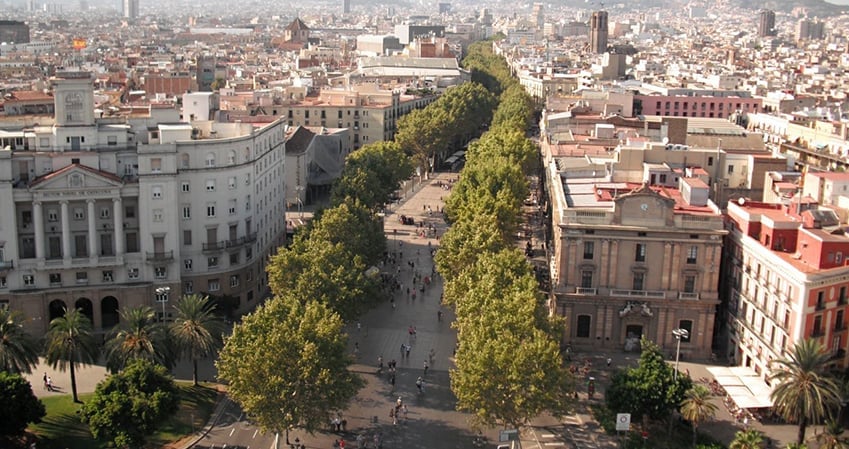 From the central square, visitors head down La Rambla—an iconic boulevard known for its striking architecture and vibrant shopping scene. Stretching about 1.2 km, La Rambla is famed for its lively atmosphere, street performers, and artists. Here you’ll find local brand stores, small souvenir shops, and restaurants serving Catalan cuisine. At the end of the boulevard stands the monument to Christopher Columbus, built between 1882 and 1888, and the Port Vell waterfront area, which was redeveloped for the 1992 Olympic Games.
From the central square, visitors head down La Rambla—an iconic boulevard known for its striking architecture and vibrant shopping scene. Stretching about 1.2 km, La Rambla is famed for its lively atmosphere, street performers, and artists. Here you’ll find local brand stores, small souvenir shops, and restaurants serving Catalan cuisine. At the end of the boulevard stands the monument to Christopher Columbus, built between 1882 and 1888, and the Port Vell waterfront area, which was redeveloped for the 1992 Olympic Games.
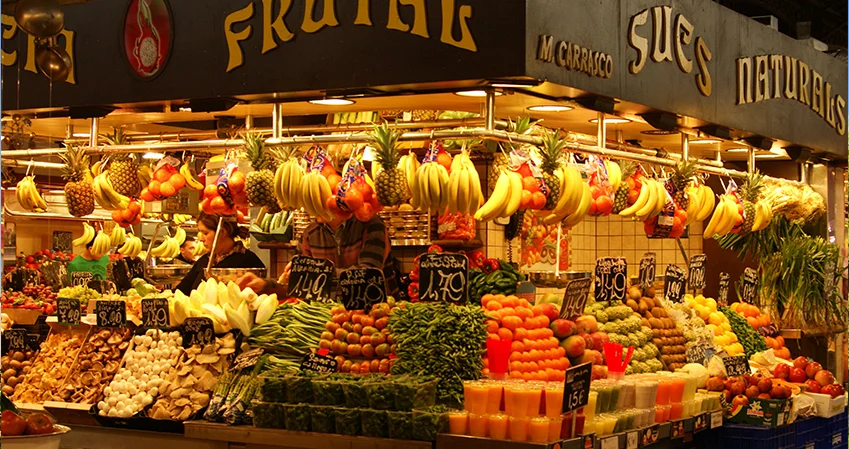 The next stop on the walking tour is La Boqueria—a large open market that dates back to the early 13th century. Located in the Old Town, this market offers a wide range of fresh local products, delicacies, snacks, and prepared dishes. Here you can sample oysters from the Ebro Delta, exquisite jamón, Catalan clementines, and Aitona peaches. There are many small eateries within the market offering meat and seafood dishes, freshly squeezed juices, and smoothies.
The next stop on the walking tour is La Boqueria—a large open market that dates back to the early 13th century. Located in the Old Town, this market offers a wide range of fresh local products, delicacies, snacks, and prepared dishes. Here you can sample oysters from the Ebro Delta, exquisite jamón, Catalan clementines, and Aitona peaches. There are many small eateries within the market offering meat and seafood dishes, freshly squeezed juices, and smoothies.
 Directly from the market, you’ll reach the Royal Square—home to some of the best restaurants, cocktail bars, and most popular nightclubs in Barcelona. It’s a favorite meeting place and a venue for many music and dance festivals, beloved by both locals and visitors.
Directly from the market, you’ll reach the Royal Square—home to some of the best restaurants, cocktail bars, and most popular nightclubs in Barcelona. It’s a favorite meeting place and a venue for many music and dance festivals, beloved by both locals and visitors.
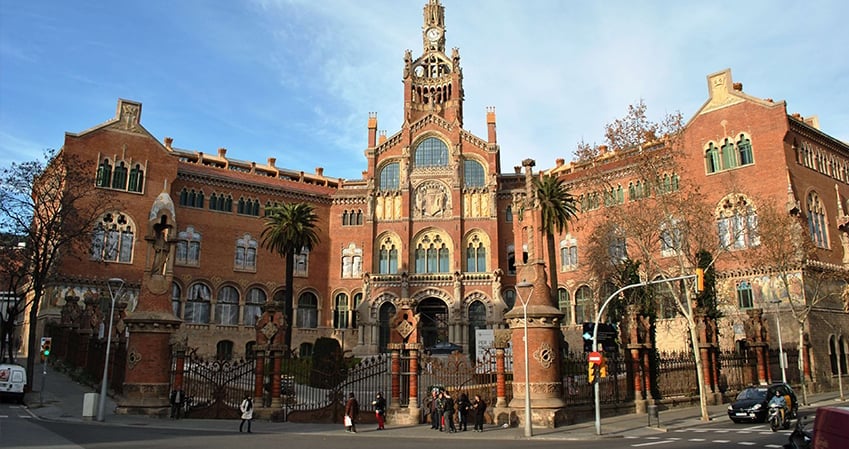 The walking route ends at the Hospital de Sant Pau, a hospital complex consisting of 12 pavilions connected by long underground galleries. Its origins date back to the early 15th century, and it was later redesigned between 1901 and 1930 by Barcelona’s prominent architect Lluís Domènech i Montaner.
The walking route ends at the Hospital de Sant Pau, a hospital complex consisting of 12 pavilions connected by long underground galleries. Its origins date back to the early 15th century, and it was later redesigned between 1901 and 1930 by Barcelona’s prominent architect Lluís Domènech i Montaner.
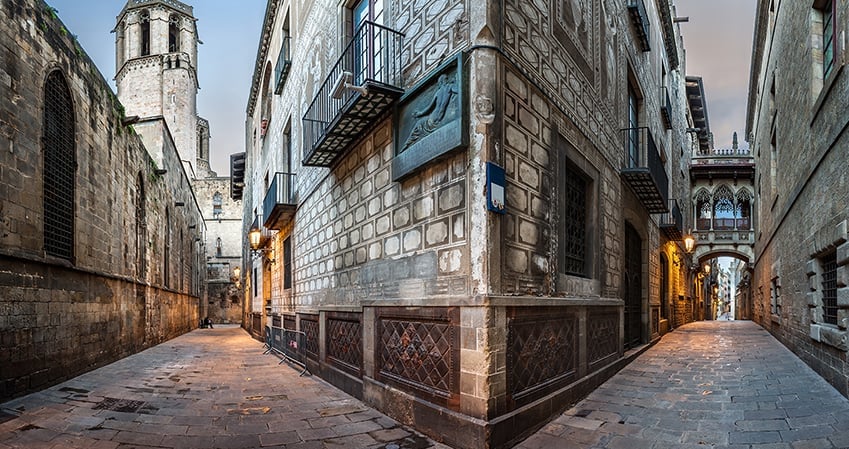 The route begins again at the central Plaça de Catalunya. From there, visitors enter Barcelona’s Gothic Quarter—the historical heart of the city, known for its authentic medieval architecture and unique ambiance. The main cathedral, the Cathedral of the Holy Cross and Saint Eulalia, was built between the late 13th and mid-15th centuries. The quarter also houses the City History Museum, the Pignatelli Palace (Royal Museum of Fine Arts), and the Aguilar Palace (Picasso Museum).
The route begins again at the central Plaça de Catalunya. From there, visitors enter Barcelona’s Gothic Quarter—the historical heart of the city, known for its authentic medieval architecture and unique ambiance. The main cathedral, the Cathedral of the Holy Cross and Saint Eulalia, was built between the late 13th and mid-15th centuries. The quarter also houses the City History Museum, the Pignatelli Palace (Royal Museum of Fine Arts), and the Aguilar Palace (Picasso Museum).
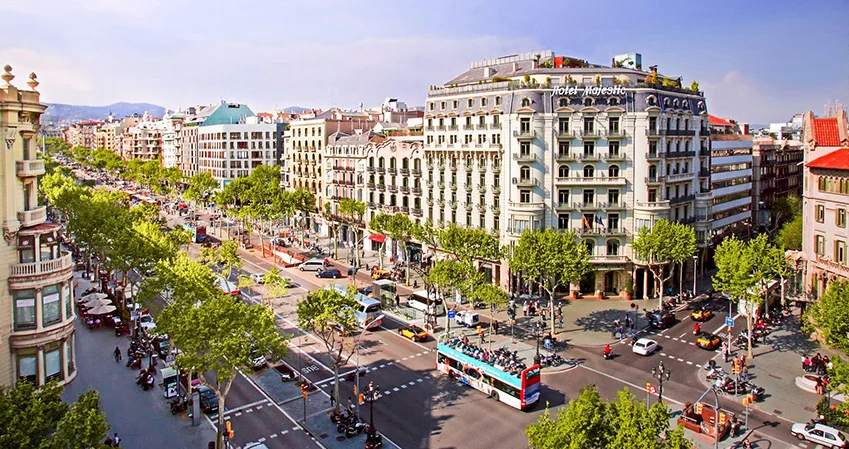 Next, you arrive at Passeig de Gràcia, one of the city’s main business districts. However, it is better known not for business but for its architectural landmarks. This is where you'll find Casa Batlló and Casa Milà—masterpieces of the great Antoni Gaudí. While the former is now a full-fledged museum, the latter still serves as a residential building.
Next, you arrive at Passeig de Gràcia, one of the city’s main business districts. However, it is better known not for business but for its architectural landmarks. This is where you'll find Casa Batlló and Casa Milà—masterpieces of the great Antoni Gaudí. While the former is now a full-fledged museum, the latter still serves as a residential building.
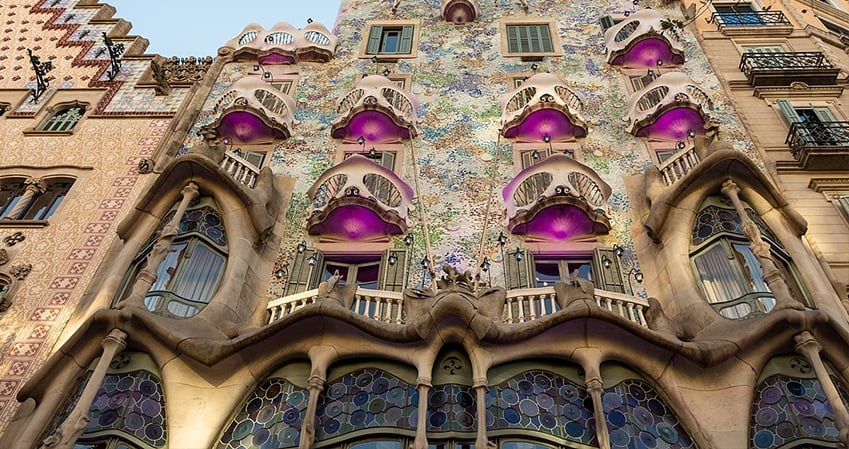 A visit to Barcelona wouldn’t be complete without seeing Gaudí’s most famous creation—the Sagrada Família. This breathtaking Catholic basilica has been under construction for 136 years. The original architect was Francisco de Paula del Villar, but after disagreements with the church, he handed the project to his then little-known apprentice, Antoni Gaudí. The cathedral's unique architecture and interior design make it one of the city's top attractions. Gaudí himself is buried in the crypt of this church.
A visit to Barcelona wouldn’t be complete without seeing Gaudí’s most famous creation—the Sagrada Família. This breathtaking Catholic basilica has been under construction for 136 years. The original architect was Francisco de Paula del Villar, but after disagreements with the church, he handed the project to his then little-known apprentice, Antoni Gaudí. The cathedral's unique architecture and interior design make it one of the city's top attractions. Gaudí himself is buried in the crypt of this church.
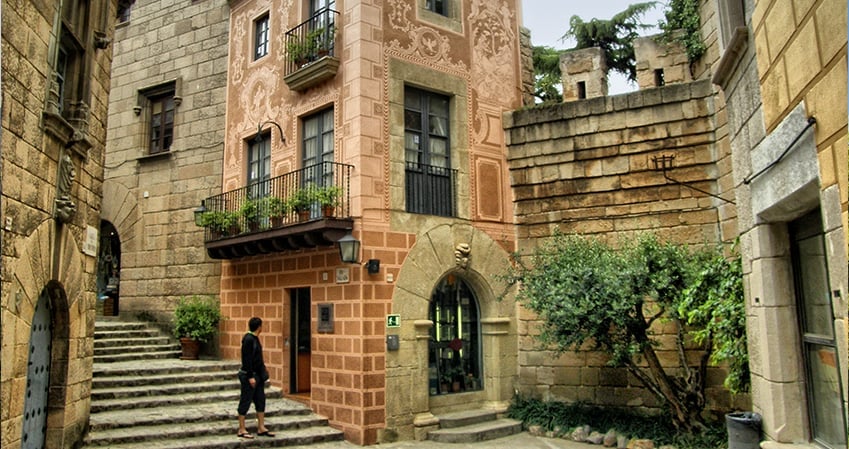 This tourist route in Barcelona begins with a climb up Montjuïc Hill and a visit to the Spanish Village—an open-air architectural and ethnographic museum. Spanning over 4 square kilometers, the museum features a complex of 117 buildings, all replicas of the most iconic structures from across the Iberian Peninsula. Here, visitors can learn about the country's history, explore its culinary traditions, and attend workshops held by local artisans. All regions of Spain are represented in the Spanish Village. A tour here is not only educational but also highly engaging.
This tourist route in Barcelona begins with a climb up Montjuïc Hill and a visit to the Spanish Village—an open-air architectural and ethnographic museum. Spanning over 4 square kilometers, the museum features a complex of 117 buildings, all replicas of the most iconic structures from across the Iberian Peninsula. Here, visitors can learn about the country's history, explore its culinary traditions, and attend workshops held by local artisans. All regions of Spain are represented in the Spanish Village. A tour here is not only educational but also highly engaging.
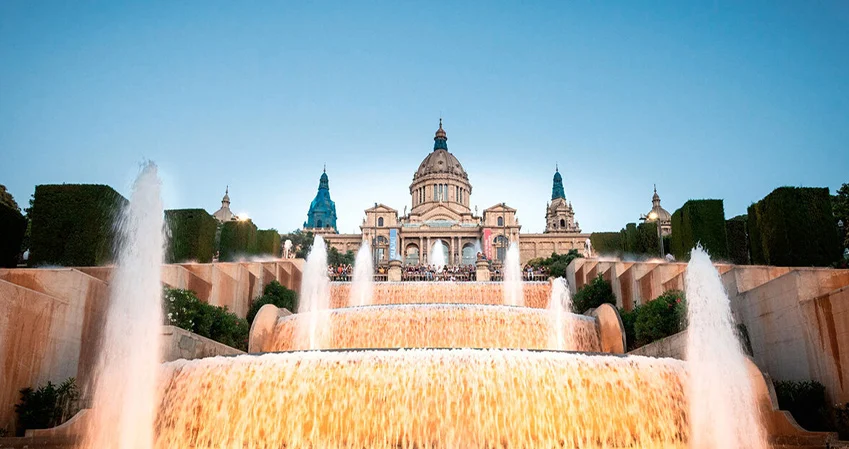 After spending almost the whole day in the Spanish Village, you can end your journey with a visit to the spectacular “Magic Fountain of Montjuïc.” Designed and built in 1929 for the International Exhibition hosted in the Catalan capital, the fountain offers a breathtaking show that combines music with water acrobatics.
After spending almost the whole day in the Spanish Village, you can end your journey with a visit to the spectacular “Magic Fountain of Montjuïc.” Designed and built in 1929 for the International Exhibition hosted in the Catalan capital, the fountain offers a breathtaking show that combines music with water acrobatics.
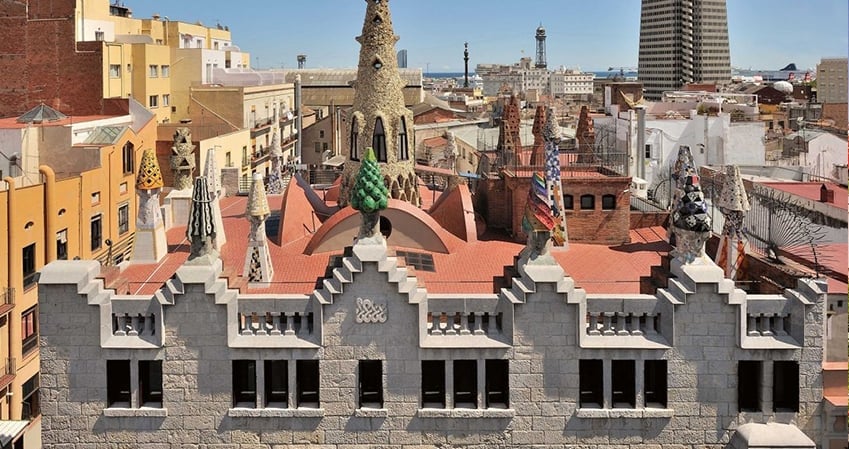 This tourist route through Barcelona is closely tied to the legacy of the great Antoni Gaudí. Begin your tour with the Palau Güell, a 19th-century mansion designed by Gaudí and listed as a UNESCO World Heritage Site.
This tourist route through Barcelona is closely tied to the legacy of the great Antoni Gaudí. Begin your tour with the Palau Güell, a 19th-century mansion designed by Gaudí and listed as a UNESCO World Heritage Site.
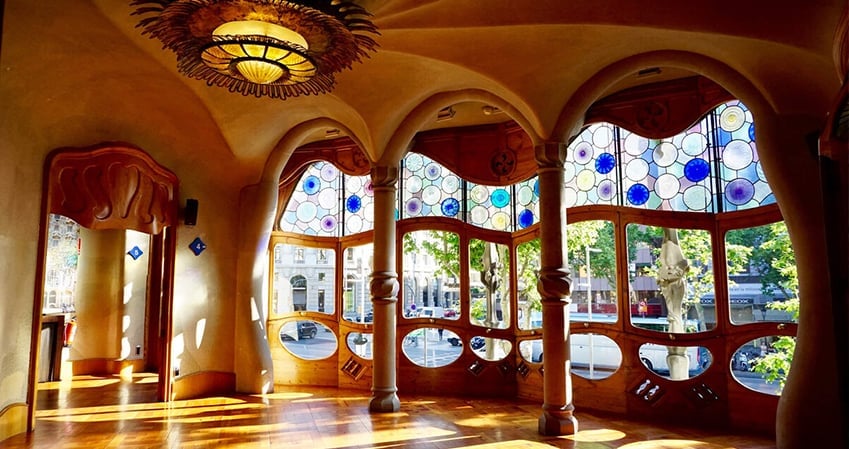 Next, walk to Passeig de Gràcia to see Casa Milà—Gaudí’s last private residential project. It’s highly recommended to plan your visit and book tickets in advance, as the queue can be over an hour long. From the rooftop terrace, you'll enjoy stunning views of the city, while the interior design is another compelling reason to explore this still-inhabited building. Further along the boulevard is another Gaudí masterpiece—Casa Batlló, often nicknamed the “House of Bones.” This magnificent museum is famous for its dreamlike façade, which everyone interprets in their own way. Yet the interior is even more colorful, imaginative, and astonishing.
Next, walk to Passeig de Gràcia to see Casa Milà—Gaudí’s last private residential project. It’s highly recommended to plan your visit and book tickets in advance, as the queue can be over an hour long. From the rooftop terrace, you'll enjoy stunning views of the city, while the interior design is another compelling reason to explore this still-inhabited building. Further along the boulevard is another Gaudí masterpiece—Casa Batlló, often nicknamed the “House of Bones.” This magnificent museum is famous for its dreamlike façade, which everyone interprets in their own way. Yet the interior is even more colorful, imaginative, and astonishing.
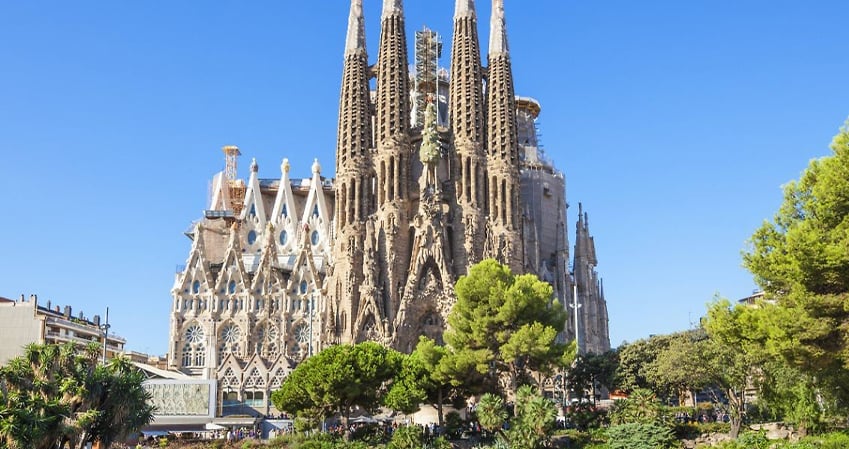 The final stop on this route is one of the most beautiful churches in Barcelona—La Sagrada Família. This unique basilica, which resembles a sandcastle in some ways, was initially started by Gaudí’s mentor, Francisco de Paula del Villar. A few years later, he handed the project over to Antoni Gaudí, who managed to complete only about 25% of the church during his lifetime. Construction of the Expiatory Church of the Holy Family has continued for over 130 years since the laying of the first stone—and it is still ongoing today.
The final stop on this route is one of the most beautiful churches in Barcelona—La Sagrada Família. This unique basilica, which resembles a sandcastle in some ways, was initially started by Gaudí’s mentor, Francisco de Paula del Villar. A few years later, he handed the project over to Antoni Gaudí, who managed to complete only about 25% of the church during his lifetime. Construction of the Expiatory Church of the Holy Family has continued for over 130 years since the laying of the first stone—and it is still ongoing today.
Go back to the blog
First Walking Route: Sightseeing Tour
Plaça de Catalunya
 The walk begins at the famous Plaça de Catalunya, the unofficial center of Barcelona. It serves as a connecting point between the Old Town and the Eixample district (the New Town). The square covers more than 50,000 m² and is the starting point of nine streets in Barcelona. The center is paved with colorful granite tiles. In front of the Spanish Credit Bank building, you'll find two large fountains and a small square adorned with antique statues. Locals often relax on the lawn next to the fountains during their lunch breaks. Plaça de Catalunya is a symbolic place for the Catalan capital and hosts demonstrations, exhibitions, and festivals—such as the Mercè Festival in autumn.
The walk begins at the famous Plaça de Catalunya, the unofficial center of Barcelona. It serves as a connecting point between the Old Town and the Eixample district (the New Town). The square covers more than 50,000 m² and is the starting point of nine streets in Barcelona. The center is paved with colorful granite tiles. In front of the Spanish Credit Bank building, you'll find two large fountains and a small square adorned with antique statues. Locals often relax on the lawn next to the fountains during their lunch breaks. Plaça de Catalunya is a symbolic place for the Catalan capital and hosts demonstrations, exhibitions, and festivals—such as the Mercè Festival in autumn.
La Rambla Boulevard
 From the central square, visitors head down La Rambla—an iconic boulevard known for its striking architecture and vibrant shopping scene. Stretching about 1.2 km, La Rambla is famed for its lively atmosphere, street performers, and artists. Here you’ll find local brand stores, small souvenir shops, and restaurants serving Catalan cuisine. At the end of the boulevard stands the monument to Christopher Columbus, built between 1882 and 1888, and the Port Vell waterfront area, which was redeveloped for the 1992 Olympic Games.
From the central square, visitors head down La Rambla—an iconic boulevard known for its striking architecture and vibrant shopping scene. Stretching about 1.2 km, La Rambla is famed for its lively atmosphere, street performers, and artists. Here you’ll find local brand stores, small souvenir shops, and restaurants serving Catalan cuisine. At the end of the boulevard stands the monument to Christopher Columbus, built between 1882 and 1888, and the Port Vell waterfront area, which was redeveloped for the 1992 Olympic Games.
La Boqueria Market
 The next stop on the walking tour is La Boqueria—a large open market that dates back to the early 13th century. Located in the Old Town, this market offers a wide range of fresh local products, delicacies, snacks, and prepared dishes. Here you can sample oysters from the Ebro Delta, exquisite jamón, Catalan clementines, and Aitona peaches. There are many small eateries within the market offering meat and seafood dishes, freshly squeezed juices, and smoothies.
The next stop on the walking tour is La Boqueria—a large open market that dates back to the early 13th century. Located in the Old Town, this market offers a wide range of fresh local products, delicacies, snacks, and prepared dishes. Here you can sample oysters from the Ebro Delta, exquisite jamón, Catalan clementines, and Aitona peaches. There are many small eateries within the market offering meat and seafood dishes, freshly squeezed juices, and smoothies.
Plaça Reial (Royal Square)
 Directly from the market, you’ll reach the Royal Square—home to some of the best restaurants, cocktail bars, and most popular nightclubs in Barcelona. It’s a favorite meeting place and a venue for many music and dance festivals, beloved by both locals and visitors.
Directly from the market, you’ll reach the Royal Square—home to some of the best restaurants, cocktail bars, and most popular nightclubs in Barcelona. It’s a favorite meeting place and a venue for many music and dance festivals, beloved by both locals and visitors.
Hospital de Sant Pau
 The walking route ends at the Hospital de Sant Pau, a hospital complex consisting of 12 pavilions connected by long underground galleries. Its origins date back to the early 15th century, and it was later redesigned between 1901 and 1930 by Barcelona’s prominent architect Lluís Domènech i Montaner.
The walking route ends at the Hospital de Sant Pau, a hospital complex consisting of 12 pavilions connected by long underground galleries. Its origins date back to the early 15th century, and it was later redesigned between 1901 and 1930 by Barcelona’s prominent architect Lluís Domènech i Montaner.
Second Walking Route: Gothic Quarter and Passeig de Gràcia
This second journey through Barcelona will help you understand what makes the Catalan capital so distinct from other European cities.Gothic Quarter
 The route begins again at the central Plaça de Catalunya. From there, visitors enter Barcelona’s Gothic Quarter—the historical heart of the city, known for its authentic medieval architecture and unique ambiance. The main cathedral, the Cathedral of the Holy Cross and Saint Eulalia, was built between the late 13th and mid-15th centuries. The quarter also houses the City History Museum, the Pignatelli Palace (Royal Museum of Fine Arts), and the Aguilar Palace (Picasso Museum).
The route begins again at the central Plaça de Catalunya. From there, visitors enter Barcelona’s Gothic Quarter—the historical heart of the city, known for its authentic medieval architecture and unique ambiance. The main cathedral, the Cathedral of the Holy Cross and Saint Eulalia, was built between the late 13th and mid-15th centuries. The quarter also houses the City History Museum, the Pignatelli Palace (Royal Museum of Fine Arts), and the Aguilar Palace (Picasso Museum).
Passeig de Gràcia
 Next, you arrive at Passeig de Gràcia, one of the city’s main business districts. However, it is better known not for business but for its architectural landmarks. This is where you'll find Casa Batlló and Casa Milà—masterpieces of the great Antoni Gaudí. While the former is now a full-fledged museum, the latter still serves as a residential building.
Next, you arrive at Passeig de Gràcia, one of the city’s main business districts. However, it is better known not for business but for its architectural landmarks. This is where you'll find Casa Batlló and Casa Milà—masterpieces of the great Antoni Gaudí. While the former is now a full-fledged museum, the latter still serves as a residential building.
Gaudí’s Masterpieces
 A visit to Barcelona wouldn’t be complete without seeing Gaudí’s most famous creation—the Sagrada Família. This breathtaking Catholic basilica has been under construction for 136 years. The original architect was Francisco de Paula del Villar, but after disagreements with the church, he handed the project to his then little-known apprentice, Antoni Gaudí. The cathedral's unique architecture and interior design make it one of the city's top attractions. Gaudí himself is buried in the crypt of this church.
A visit to Barcelona wouldn’t be complete without seeing Gaudí’s most famous creation—the Sagrada Família. This breathtaking Catholic basilica has been under construction for 136 years. The original architect was Francisco de Paula del Villar, but after disagreements with the church, he handed the project to his then little-known apprentice, Antoni Gaudí. The cathedral's unique architecture and interior design make it one of the city's top attractions. Gaudí himself is buried in the crypt of this church.
Third Walking Route: The Magic Fountain and the Spanish Village
The Spanish Village
 This tourist route in Barcelona begins with a climb up Montjuïc Hill and a visit to the Spanish Village—an open-air architectural and ethnographic museum. Spanning over 4 square kilometers, the museum features a complex of 117 buildings, all replicas of the most iconic structures from across the Iberian Peninsula. Here, visitors can learn about the country's history, explore its culinary traditions, and attend workshops held by local artisans. All regions of Spain are represented in the Spanish Village. A tour here is not only educational but also highly engaging.
This tourist route in Barcelona begins with a climb up Montjuïc Hill and a visit to the Spanish Village—an open-air architectural and ethnographic museum. Spanning over 4 square kilometers, the museum features a complex of 117 buildings, all replicas of the most iconic structures from across the Iberian Peninsula. Here, visitors can learn about the country's history, explore its culinary traditions, and attend workshops held by local artisans. All regions of Spain are represented in the Spanish Village. A tour here is not only educational but also highly engaging.
The Magic Fountain
 After spending almost the whole day in the Spanish Village, you can end your journey with a visit to the spectacular “Magic Fountain of Montjuïc.” Designed and built in 1929 for the International Exhibition hosted in the Catalan capital, the fountain offers a breathtaking show that combines music with water acrobatics.
After spending almost the whole day in the Spanish Village, you can end your journey with a visit to the spectacular “Magic Fountain of Montjuïc.” Designed and built in 1929 for the International Exhibition hosted in the Catalan capital, the fountain offers a breathtaking show that combines music with water acrobatics.
Fourth Walking Route: The Works of Antoni Gaudí
Palau Güell
 This tourist route through Barcelona is closely tied to the legacy of the great Antoni Gaudí. Begin your tour with the Palau Güell, a 19th-century mansion designed by Gaudí and listed as a UNESCO World Heritage Site.
This tourist route through Barcelona is closely tied to the legacy of the great Antoni Gaudí. Begin your tour with the Palau Güell, a 19th-century mansion designed by Gaudí and listed as a UNESCO World Heritage Site.
Casa Batlló and Casa Milà
 Next, walk to Passeig de Gràcia to see Casa Milà—Gaudí’s last private residential project. It’s highly recommended to plan your visit and book tickets in advance, as the queue can be over an hour long. From the rooftop terrace, you'll enjoy stunning views of the city, while the interior design is another compelling reason to explore this still-inhabited building. Further along the boulevard is another Gaudí masterpiece—Casa Batlló, often nicknamed the “House of Bones.” This magnificent museum is famous for its dreamlike façade, which everyone interprets in their own way. Yet the interior is even more colorful, imaginative, and astonishing.
Next, walk to Passeig de Gràcia to see Casa Milà—Gaudí’s last private residential project. It’s highly recommended to plan your visit and book tickets in advance, as the queue can be over an hour long. From the rooftop terrace, you'll enjoy stunning views of the city, while the interior design is another compelling reason to explore this still-inhabited building. Further along the boulevard is another Gaudí masterpiece—Casa Batlló, often nicknamed the “House of Bones.” This magnificent museum is famous for its dreamlike façade, which everyone interprets in their own way. Yet the interior is even more colorful, imaginative, and astonishing.
The Expiatory Church of the Holy Family (Sagrada Família)
 The final stop on this route is one of the most beautiful churches in Barcelona—La Sagrada Família. This unique basilica, which resembles a sandcastle in some ways, was initially started by Gaudí’s mentor, Francisco de Paula del Villar. A few years later, he handed the project over to Antoni Gaudí, who managed to complete only about 25% of the church during his lifetime. Construction of the Expiatory Church of the Holy Family has continued for over 130 years since the laying of the first stone—and it is still ongoing today.
The final stop on this route is one of the most beautiful churches in Barcelona—La Sagrada Família. This unique basilica, which resembles a sandcastle in some ways, was initially started by Gaudí’s mentor, Francisco de Paula del Villar. A few years later, he handed the project over to Antoni Gaudí, who managed to complete only about 25% of the church during his lifetime. Construction of the Expiatory Church of the Holy Family has continued for over 130 years since the laying of the first stone—and it is still ongoing today.


 12/05/2025
12/05/2025  Reading time: 7 min
Reading time: 7 min 
